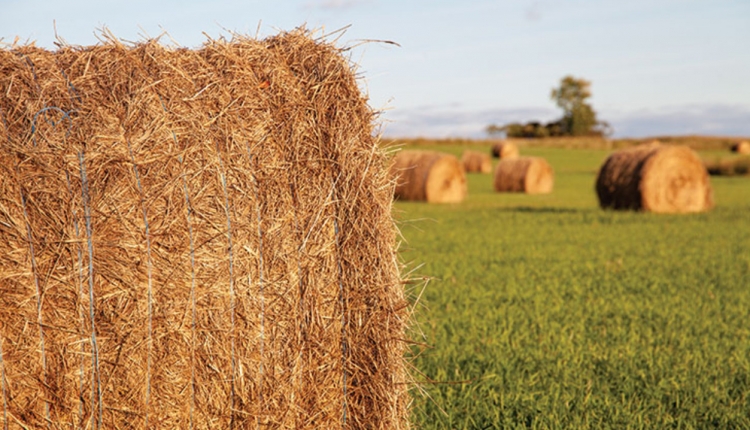The author is a rancher, author, speaker, and consultant with over 40 years of experience in grazing management research, outreach, and practice. He has lived and grazed livestock in hot, humid Missouri and cold, dry Idaho.

Making hay is an expensive process these days. Harvest costs are up because of the current high cost of diesel fuel, labor, equipment repairs, and machinery costs. The price of fertilizer has also risen substantially over the last couple of years. When hay is harvested, we are taking off a relatively large volume of nitrogen and soil minerals. Hay typically removes more than 80% of the minerals in the above-ground portion of the plant.
If we just think in terms of nitrogen (N), phosphorus (P), potassium (K), and sulfur (S), each ton of hay removed contains 30 to 50 pounds of N, 5 to 7 pounds of P, 30 to 70 pounds of K, and 4 to 5 pounds of S. Using current commercial fertilizer prices, the value of N-P-K-S in one ton of hay is $85 to $90. Add in the calcium, copper, cobalt, zinc, and other minerals, and we find about $15 added value based on livestock mineral supplement prices. For the first time in my life, a ton of hay contains over $100 of N-P-K-S and mineral value.
While that is a scary number from the cost of production standpoint, there are some other considerations of value.
Factor in fertility
In the eastern half of the U.S., as of September 2022, there are still many areas where a ton of hay can be purchased for less than $100 per ton. Think about that for a minute. If you purchase hay at that low price, you are bringing in $100 worth of livestock feed, but you are also bringing in $100 worth of fertility for your farm. You are either getting your feed for free or your fertilizer for free.
In the western half of the U.S., it is hard to find hay for less than about $150 per ton and much is selling for $200 to $300 per ton. Using hay for fertility building in the West is not nearly the bargain that it is in the East. When we decide to buy hay to feed our livestock, we need to be factoring the fertility value it brings to our farm or ranch.
To capture that fertility value, make sure you are feeding it in a strategic way. I have long advised my consulting clients to get into a soil testing routine whether they ever plan to buy an ounce of fertilizer or not. We use soil testing as a tool to guide where hay should be fed out. Feeding hay only has fertilizer value if it is fed in an area that will benefit from the added nutrients.
There is also the consideration of how much hay should be fed across an area for proper nutrient management. Because of the high N-P-K content of hay, we need to have target feeding amounts to avoid nutrient overload. I have seen many bale-grazing situations where excessive amounts of nutrients are being applied through nonplanned feeding regimes.
High excretion rates
It is important to understand the N and mineral content of the hay you are feeding and how the animal retains or excretes those nutrients. Nitrogen excretion is greater than 90%. Almost all other minerals are greater than 90% with K excretion being around 99%. Very little of the mineral nutrients contained in any kind of feed is actually retained in the animal’s body.
When the protein content of the feed is appropriate for the animal’s requirement, N excretion is split evenly between urine and feces. If the protein content exceeds the requirement, all excess N passes through urine. A 14% crude protein hay contains about 45 pounds of N. If N retention is 10%, that equates to 40 pounds excreted. Based on the animal’s requirement, there may be an equal urine-feces split, or there may be somewhat higher urinary output. Remember, urinary N is highly soluble and almost immediately available for plant uptake. Fecal N is a slow-release source of N.
What is a reasonable available N application rate in the winter months?
That is a serious consideration from a nutrient loading standpoint. Let’s say our target is 100 pounds of N per acre. Knowing our hay is providing 20 pounds per ton of urinary N tells us we should be feeding no more than 5 tons per acre. If our bales weigh 1,000 pounds each, feed no more than 10 bales per acre.
If bale grazing with bales set on 40-foot centers, that would result in 27 bales per acre being placed, or nearly three times our maximum number to avoid N overload in the feeding area. This is why we really need to feed hay in a thoughtful and planned way. While we should be trying to manage nutrients in a way that does not harm the ecosystem, we also should be motivated to get that fertility put on as many acres as possible. That is where the value of the nutrients in the hay is optimized.
This article appeared in the November 2022 issue of Hay & Forage Grower on page 14.
Not a subscriber? Click to get the print magazine.

